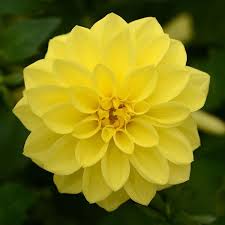1
/
of
1
Dahlia, Dalaya Yellow
Dahlia, Dalaya Yellow
Dahlia Dalaya Yellow is a vibrant and cheerful variety of dahlia, known for its striking, golden-yellow blooms. The flowers are semi-doubled and have a soft, layered structure, with petals that radiate outward in a graceful pattern. The bright yellow color is eye-catching and adds a sunny, warm touch to gardens, containers, and floral arrangements. This variety is compact, making it an excellent choice for small spaces or as an accent plant in larger garden beds.
Plant Characteristics:
- Height: Dalaya Yellow typically grows to a height of 12-18 inches (30-45 cm), making it a relatively short and compact variety of dahlia.
- Width: The spread is also around 12-18 inches (30-45 cm), creating a full, bushy plant.
- Flowers: The blooms are large, semi-doubled, and golden yellow. Each flower can reach about 3-4 inches (7-10 cm) in diameter.
- Foliage: The foliage is deep green with slightly serrated edges, which contrasts nicely with the bright yellow flowers.
Growing Zones:
- Hardiness Zone: Dahlia Dalaya Yellow is grown as a tender perennial in USDA Hardiness Zones 8-11. In colder climates (zones 3-7), it is usually grown as an annual or the tubers are dug up and overwintered indoors to protect them from frost.
Light Requirements:
- Full sun: Dahlias, including Dalaya Yellow, require full sun to thrive. They need at least 6-8 hours of direct sunlight daily for optimal growth and flowering.
Soil:
- Prefers well-draining, fertile soil with a slightly acidic to neutral pH (6.0-6.5). The soil should be rich in organic matter, such as compost, which helps retain moisture while ensuring proper drainage. Avoid heavy, clay-like soils that tend to stay wet and cause root rot.
Watering:
- Keep the soil consistently moist, but not waterlogged. Water deeply, especially during dry periods, but ensure the soil drains well to prevent standing water. Avoid overhead watering to reduce the risk of fungal diseases and encourage water to reach the roots directly.
Uses:
- Ornamental plant: Dalaya Yellow is perfect for garden beds, borders, and containers, adding a splash of bright color to any space. Its compact size makes it ideal for smaller gardens, patios, or balconies.
- Cut flowers: The beautiful golden-yellow flowers are excellent for cut flower arrangements, bringing warmth and brightness to bouquets and vases.
- Mixed borders: Dalaya Yellow pairs well with other vibrant-colored dahlias or contrasting plants, creating eye-catching combinations in flower beds and borders.
Native Range:
- Native to Mexico and Central America: Like all dahlias, Dalaya Yellow is originally from the high-altitude regions of Mexico and Central America. In its native environment, dahlias grow as perennials, but in many areas outside of their native range, they are typically grown as annuals or dug up for overwintering due to their sensitivity to frost.
Tips for Growing Dahlia Dalaya Yellow:
- Planting: Plant Dalaya Yellow after the last frost date in your region. Space the plants about 12-18 inches apart to give them room to grow. If growing from tubers, ensure the tuber is planted about 4-6 inches deep with the "eye" facing up.
- Staking: Dahlias, especially those with larger blooms, may need staking to prevent the stems from bending or breaking. Use stakes early in the growing season to avoid disturbing the roots later.
- Deadheading: Regularly remove spent flowers (deadheading) to encourage more blooms and keep the plant looking tidy.
- Fertilizing: Fertilize with a balanced, water-soluble fertilizer every 2-4 weeks during the growing season. Be careful not to over-fertilize with nitrogen, as this can lead to excess foliage growth at the expense of flowers.
- Overwintering: In regions with cold winters, dig up the tubers after the first frost. Clean and dry them, then store them in a cool, dry location until the next spring. In warmer climates, you may leave the tubers in the ground, as long as winter temperatures remain mild.
Regular price
$6.98 USD
Regular price
Sale price
$6.98 USD
Unit price
/
per
Shipping calculated at checkout.
Couldn't load pickup availability


